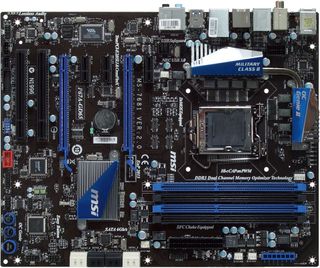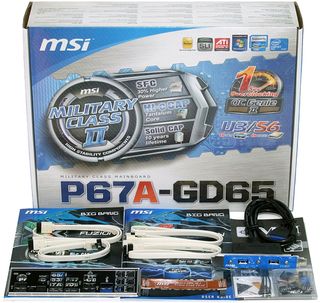P67 Motherboard Roundup: Nine $150-200 Boards
Improved per-clock performance and higher achievable frequencies are sure to put Intel’s latest K-Series CPUs on top of many builders’ whish lists, but they’ll still need a new socket to put it in. We test nine enthusiast-oriented LGA-1155 motherboards.
MSI P67A-GD65
MSI packs its P67A-GD65 with two added SATA and two USB 3.0 controllers to take second place in the scramble for best feature set, focusing the rest of its efforts on overclocking and firmware enhancements.

Those added drive controllers support two internal SATA 6Gb/s drives with RAID 0 or 1, plus two eSATA 3Gb/s drives. A single gigabit Ethernet controller handles networking needs, though the firm does retain the FireWire ports missing from its best-featured rival.
Rather than pack its processor interface area with an excessive number of CPU voltage controller phases, MSI adds heavy-duty parts to its eight-phase design. MSI makes some fairly bold statements about these parts, but the proof of the VRM is in the overclocking. We’ll put this one through the same test as all of its competitors.

A row of voltage detection pins lines the top of the front edge, surrounded by brackets that hold a voltmeter’s probes in place. The P67A-GD65’s installation kit also includes extension leads for use with that connector.
Three spaces separate the P67A-GD65’s two graphics card slots, allowing a little more airflow to the top card in SLI or CrossFire configurations. As with other motherboards in this roundup, the second slot takes half the lanes from the first whenever a card is installed there, changing the slot configuration from x16/x0 to x8/x8.
With only a single USB 2.0 header, the P67A-GD65 supports the fewest USB 2.0 front-panel ports of any motherboard we’ve seen in a few years, though the pathways for two more ports are shared with its USB 3.0 breakout connector.
While the overall design of MSI’s P67A-GD65 fits most of our needs, we see a potential problem with the two connectors located in the bottom-rear corner. The front-panel audio header is furthest from its intended jacks, and we’ve even seen a few cases with cables that were too short to reach its extreme location. The front-panel USB 3.0 header slightly forward of the bottom-rear-corner could pose similar cable reach issues, but only after cases are released that can connect to it.
Stay on the Cutting Edge
Join the experts who read Tom's Hardware for the inside track on enthusiast PC tech news — and have for over 25 years. We'll send breaking news and in-depth reviews of CPUs, GPUs, AI, maker hardware and more straight to your inbox.

One of the ways MSI avoids any issue of USB 3.0 front-panel cables that won’t reach is by not including a front-panel bay adapter. A slot plate is still included to connect these ports, along with an SLI bridge and four internal SATA cables.
-
reprotected I thought that the ECS looked pretty sick, and it did perform alright. But unfortunately, it wasn't the best.Reply -
rantsky You guys rock! Thanks for the review!Reply
I'm just missing benchmarks like SATA/USB speeds etc. Please Tom's get those numbers for us! -
rmse17 Thanks for the prompt review of the boards! I would like to see any differences in quality of audio and networking components. For example, what chipsets are used for Audio in each board, how that affects sound quality. Same thing for network, which chipset is used for networking, and bandwidth benchmarks. If you guys make part 2 to the review, it would be nice to see those features, as I think that would be one more way these boards would differentiate themselves.Reply -
VVV850 Would have been good to know the bios version for the tested motherboards. Sorry if I double posted.Reply -
flabbergasted I'm going for the ASrock because I can use my socket 775 aftermarket cooler with it.Reply -
stasdm Do not see any board worth spending money on.Reply
1. SLI "support". Do not understand why end-user has to pay for mythical SLI "sertification" (all latest Intel chips support SLI by definition) and a SLI bridge coming with the board (at least 75% of end users would never need one). The bridge should come with NVIDIA cards (same as with AMD ones). Also, in x8/x8 PCIe configuration nearly all NVIDIA cards (exept for low-end ones) will loose at least 12% productivity - with top cards that is about $100 spent for nothing (AMD cards would not see that difference). So, If those cards are coming as SLI-"sertified" they have to be, in the worst case, equipped by NVIDIA NF200 chip (though, I would not recommend to by cards with this PCIe v.1.1 bridge). As even NVIDIA GF110 cards really need less than 1GB/s bandwidth (all other NVIDIA and AMD - less than 0.8GB/s)and secondary cards in SLI/CrossFire use no more than 1/4 of that, a normal PCIe v.2.0 switch (costing less than thrown away with x8/x8 SLI money) will nicely support three "Graphics only" x16 slots, fully-functional x8 slot and will provide bandwidth enough to support one PCIe v.2.0 x4 (or 4 x x1) slot(s)/device(s).
2. Do not understand the author euphoria of mass use of Marvell "SATA 6G" chips. The PCIe x1 chip might not be "SATA 6G" by definision, as it woud newer be able to provide more than 470GB/s (which is far from the standard 600GB/s) - so, I'd recommend to denote tham as 3G+ or 6G-. As it is shown in the upper section, there is enough bandwidth for real 6G solution (PCIe x8 LSISAS 2008 or x4 LSISAS 2004). Yes, will be a bit more expensive, but do not see the reason to have a palliative solutions on $200+ mobos.
-
I was hoping that the new Asus Sabertooth P67 would be included. Its new design really is leaving people wondering if the change is as good as they claim.Reply
Most Popular


